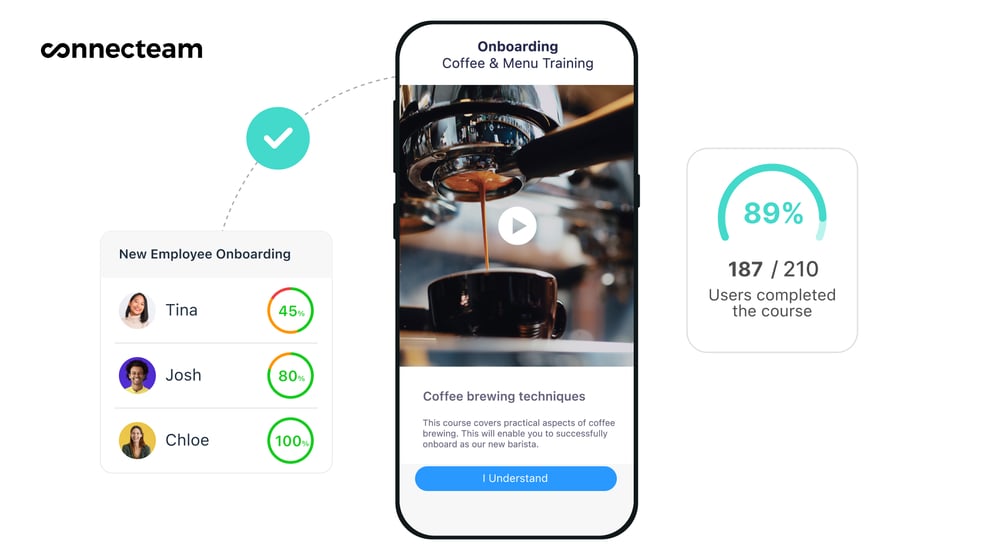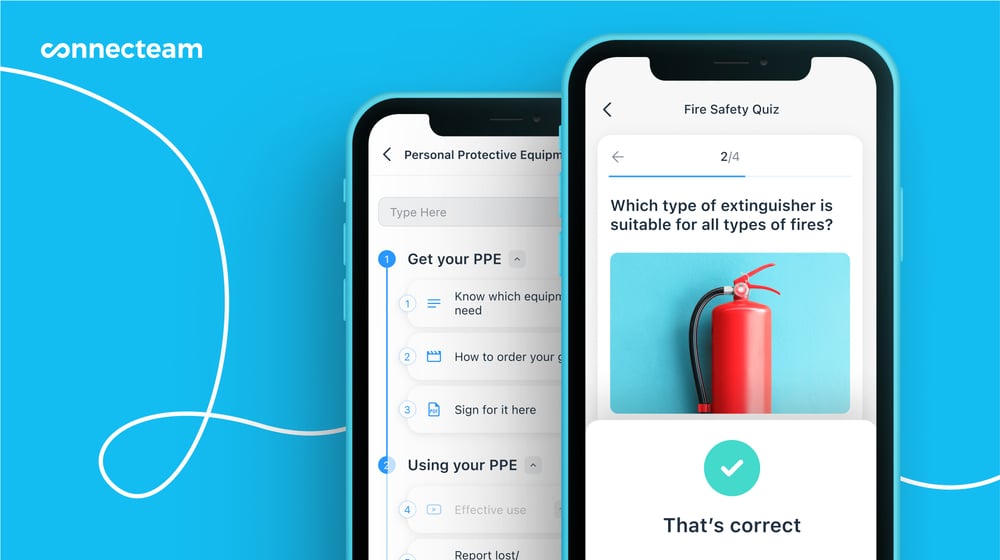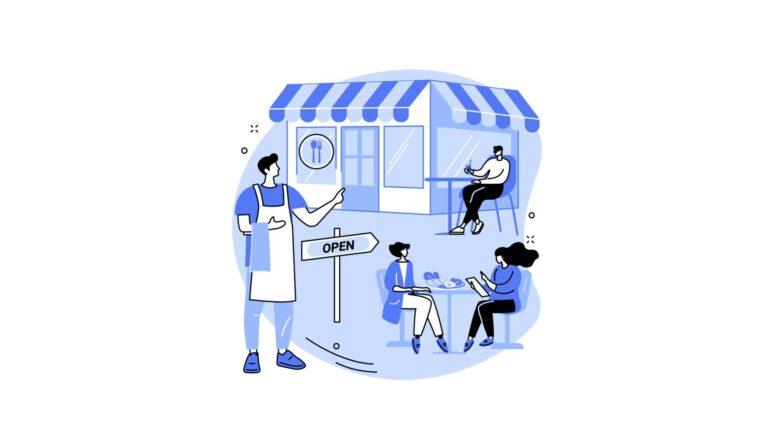Refresher training keeps you compliant and ensures employees are happy, productive, and armed with the resources they need to do their best work.
No matter how thorough your onboarding process is, refresher training is crucial. Memories fade and processes and technologies change. Refreshing skills, competencies, and best practices keeps your team sharp and poised to do their best at work.
However, deciding what to cover, how to create training, and what subjects to review can be daunting.
In this article, we’ll help you by reviewing what refresher training is, why you need it, and how you can make sure your employees are getting the best additional training. After reading, you’ll know how to deliver the best learning opportunities for your organization.
Key Takeaways
- Refresher training is post-onboarding training that reinforces what’s been learned, closes knowledge gaps, and introduces additional useful information.
- Refresher learning is important because it improves productivity and employee satisfaction, fosters better work, and keeps you compliant.
- There are a number of signs that signal your workforce needs refresher training. These include frequent mistakes, dissatisfied customers, and more.
- Connecteam makes it cost-effective and simple to create the learning opportunities your team needs.
What Is Refresher Training?
Refresher training is any post-onboarding workplace learning about a topic that was previously studied. For example, a team may take refresher classes in safety procedures annually, even if safety training is included during onboarding.
Refresher training is intended to close gaps in knowledge, keep team training updated, and, as the name suggests, refresh individuals’ memories about what they’ve already learned.
This type of training can take many forms. For instance, it can include short videos that are updated every 6 months. Or, it could mean formal, sit-down training in a classroom once a year. Decision-makers at your organization can decide what works best for you depending on your team’s needs and the material that will be taught.
Why Refresher Training Is Important
Refresher training is critical for organizations in every industry for a number of reasons. These include:
Increasing work efficiency and excellence
As employees get additional courses and information about the best practices for their job, their skills improve, which can boost efficiency.
For example, an individual who learns to use all the features of a new piece of equipment in the workplace may be able to do more work in less time.
Workers who are training regularly are also building their skills. Upskilling often leads to increased excellence at work, as employees’ abilities steadily improve.
Making fewer mistakes
Employees who get refresher training have best practices reinforced, so they’re more likely to remember the most effective ways to do their jobs. They’re less likely to make mistakes because training stays fresh in their minds.
Improving safety at work
No one wants to get injured at work, but a worker is injured, on average, every 7 seconds in the US. Trained workers who are routinely reminded of safety guidelines know how to stay safe on the job.
They’re continuously reminded of the importance of workplace safety as well. This can create a workplace culture where everyone has the knowledge and awareness to look out for each other.
Staying compliant with state and federal regulations
By federal law, some companies in the US must provide refresher training to employees. For example, manufacturing facilities that produce very dangerous products are subject to the Risk Management Program (RMP) Rule and must offer employee refresher training at least every 3 years. RMP-compliant refresher courses are required to retrain employees in operation procedures.
In addition, the Occupational Safety and Health Administration (OSHA) requires employees in most industries to receive at least annual safety training. This may include hearing protection, hazardous waste and emergency response, and respiratory protection retraining. There may also be other requirements, depending on your industry.
Many states have their own laws about employee refresher training. In California, for example, healthcare workers need annual refresher training about workplace violence.
Pro Tip
You can check your state government or state labor agency website to find out what training and refresher training your state requires. In addition, Connecteam has a guide on compliance training and an archive of state labor laws you can reference.
Creating a culture of learning
Providing ongoing training instead of a one-off event helps create a culture of learning, where teams are encouraged and rewarded for seeking and sharing knowledge.
Refresher classes make learning part of the fabric of everyday life in your workplace. This can boost curiosity and encourage an ongoing commitment to learning and growth.
Increasing employee confidence and happiness
Employees who learn regularly are always honing their skills. This can make them feel more confident in their ability to do their job well.
Refresher training gives individuals the tools they need to perform well, which can improve their happiness at work. It can also make employees feel seen and like your organization is investing in them.
This in turn can encourage employees to stay at your business long-term. In fact, studies show that the right employee training can reduce turnover by up to 35%.
Identifying learning gaps
As you start to offer refresher classes, you may realize you’ve made some incorrect assumptions about what your team knows. In a class about workplace tech, for example, you could identify a lack of awareness about cybersecurity.
It’s not uncommon to set up one class only to find that an additional refresher course is needed to address questions and gaps that emerge in the first training.
You can then provide extra classes or resources. This creates a path of learning, where employees can continuously improve. It can also help you improve safety and productivity before problems have a chance to arise from undertraining.
Keeping up with new workplace information
Onboarding is about getting employees up to speed with current processes, tech, and information. Over time, though, new products will emerge, your company priorities will change, and new trends and marketplace information will change how you do things at your organization.
Refresher training ensures everyone at your organization is keeping up with current expectations and processes. In turn, this contributes to a sense of togetherness across your company, which makes for a more positive working environment.

Signs Your Workplace Needs Refresher Training
So, when is refresher training required?
You may decide that some types of training (like customer service or safety training) get scheduled on the calendar every 2 months, 6 months, or 1 year to keep everyone’s skills fresh.
However, you might notice signs your team needs some supplemental materials. In general, refresher training is needed when you notice:
Frequent mistakes and injuries
Mistakes happen in every workplace, but if they’re happening often, it could be a sign your employees need more training.
Pay special attention to safety mistakes and near-injuries. These could be indications you need additional safety classes.
Your team isn’t using technology or new procedures correctly
Whenever you launch new tech in your workplace, such as new software or a new piece of machinery, you’re probably offering some initial training. You might want to offer additional classes, too, if you notice your team isn’t using the software correctly or is ignoring some of the features they’ve been taught.
The same goes for new or updated policies, processes, and procedures. Employees who aren’t grasping a new way of doing things may need some follow-up training.
Unhappy customers
Are you noticing fewer repeat customers or a jump in client complaints? It could be a sign that your employees need a refresher in customer service. Or, they could benefit from more training in procedures so they can serve customers more effectively and with fewer mistakes.
Productivity decreases and turnover increases
Ask your staff if they feel they’ve had enough training and refresher classes if you notice productivity dropping and more talent leaving your business, especially after you’ve made a change.
For example, you might notice front-desk staff are ringing up orders slower and are expressing more dissatisfaction if they can’t use the point of sale (POS) system properly. Eventually, you could notice more workers quitting.
As soon as you notice productivity slowing, follow-up training can help team members understand how to do their tasks better and faster. This can make them feel more confident at work and more equipped to do their job well.
Pro Tip
It can cost your company tens of thousands of dollars (or more) to get in-person or live online refresher training from an experienced facilitator. Even general online classes can cost thousands of dollars. If you’re considering refresher training but budget and value are important, creating your own customizable training with Connecteam is a highly effective, affordable solution.
Get started with Connecteam for free today!
Typical Refresher Training Topics
There’s no limit to the topics you can cover in refresher training. Anything your employees need to do their jobs well is fair game.
Here are some topics most companies find useful to review regularly:
- Customer service, including the best ways to create a great impression and ways to deal with difficult clients.
- Risk assessment, including identifying the most common hazards in your workplace and mitigating them.
- Safety training, including the use of safety equipment, avoiding repetitive strain injuries, safety protocols, and more.
- Cybersecurity, including best practices for passwords and proper handling of sensitive information.
- Compliance requirements, such as reviews of the Health Insurance Portability and Accountability Act (HIPAA) in healthcare settings.
- Company-specific policies and procedures, to ensure all employees are familiar with the specific rules and guidelines to follow at the organization—especially any recently added or updated ones.
6 Refresher Training Methods
There are multiple ways to deliver learning opportunities to your team. These include:
Microlearning
Microlearning refers to short, targeted teaching systems. Short training videos of 1-2 minutes, for example, are a form of microlearning.
With microlearning, employees can easily dip into training when they have a spare minute. This makes learning more accessible, even for busy teams.
Rather than producing long and expensive videos, simply grab a phone and film yourself or one of your workers explaining a new process or policy. This is a fantastic way to quickly get relevant knowledge to your staff with minimal production effort and costs.
Microlearning is best for very specific topics. For example, utility workers may get a short training session about how to fill out an updated order service form.
This type of training is also beneficial for regular updates. Employees in the restaurant industry, for instance, can receive microlearning sessions covering new food safety protocols or food preparation techniques.
Moreover, microlearning increases the efficiency of the learning process by up to 17%. This may be because it’s highly targeted and focuses only on one idea, so individuals don’t have to remember lots of complex information. It’s also easy to review often, which can help with knowledge retention.

In-person learning
Its name says it all: In-person learning gets employees face-to-face with instructors and each other. It’s a more formal learning style, but individuals may feel more engaged because there are fewer distractions.
Face-to-face learning is a good option for refresher classes focused on important topics like safety. This is because there’s less of a chance that employees will get distracted and not absorb the information properly.
Virtual classrooms
These are digital learning environments where students and instructors engage in live, interactive learning—right from their homes or workplaces. They can also encompass virtual reality (VR) classroom experiences, where individuals use VR headsets to attend training sessions.
Virtual classrooms are a valid option when live learning is best but meeting in person isn’t possible. This style of training is good for introducing updated policies or procedures, covering updates to software, or any topic where live demonstration is important.
Plus, virtual classrooms can improve learning outcomes. According to one 2021 study, individuals who received personalized training through 3D virtual reality classrooms remembered 30% more information and received 20% higher scores on tests when compared with a control group using traditional educational tools.
Online courses
E-learning means delivering training in a digital format, with videos, slides, files, and other online resources. Online courses usually follow a set structure. For example, an employee may need to read a short article and then complete a quiz.
Online learning also gives employees an opportunity to access resources such as checklists, worksheets, informational documents, and other training materials that can help them do their jobs.
This style of learning is best for upskilling and for topics that require a deeper dive, such as customer service. This is because you can spend as much time as you need explaining a topic.
Furthermore, when you use e-learning, you can include multiple training resources, deliver more training sessions more easily, and allow employees to complete training at their own pace.
Hands-on training
Hands-on learning can happen in person or online. It involves asking employees to try a specific method or technology personally so they can learn.
For example, you might guide employees step-by-step through the process of using a new printer, asking them to type in the commands or press the buttons you indicate.
Hands-on training is best for learning software features, tech, and step-by-step procedures, such as putting on safety equipment or closing a restaurant for the night. It’s effective because employees get to practice with guidance, then get to try on their own.
Blended learning
This style of learning is also known as technology-mediated instruction or mixed-mode instruction. It’s a type of training that combines online and in-person classes.
Blended learning is a good option for most topics. It gives participants a chance to learn from each other and see demonstrations or try hands-on learning. It also lets learners study on their own with online material that can go into more depth.
Pro Tip
As you consider how to deliver learning material, think about whether employee rewards might encourage your team to complete and engage with training. We’ve created a comprehensive guide to employee rewards and recognition that can help you get started.
How To Conduct Refresher Training Online
So, now that you know why you need refresher training, let’s look closer at how to create refresher classes.
Identify your training needs and determine the frequency of training
First, identify who at your organization needs what kind of training. In general, all employees will need refresher training on safety at least once a year, but what they need to learn will depend on their job roles and your state rules.
A good way to determine who needs training is to look at performance reviews to see who has been struggling with mistakes and productivity.
Another way to uncover what training everyone needs is to send out a survey, asking about any knowledge gaps your team feels they have.
Next, determine how often training needs to happen. Many companies conduct annual updates to training, but you may find you need more frequent refreshers.
Consider this if you’re not sure how often to schedule training: Frequent repetition has been shown to improve long-term recall by 35%. Very short training sessions, done monthly or more often, can help teams remember what they learn without overwhelming them.
Run an audit of existing training material
Refresher training should build on what exists, so review what training your team has already received through onboarding and past refresher courses.
What’s most important to reinforce through repetition? What has been updated and needs new training? What hasn’t been covered yet? You can then create new learning materials to address these points.
Pro Tip
As you create training materials, find a way to store and organize them so you and your team can easily refer back to them as needed. Connecteam makes it simple to keep all your training in one spot, and its Knowledge Center lets you securely store manuals, checklists, reading materials, and other important documents in a digital library.
Create new learning materials
Once you understand who needs refresher training and what they’ve already learned, it’s time to create new training.
Connecteam can help. Our all-in-one work management platform lets you create short 1-to-2-minute training videos as well as fully customizable training modules. You can text, images, files, HTML elements, audio notes, and more to your courses. Plus, you can add quizzes to test employees’ knowledge after training is complete.
Training courses and materials are accessible through Connecteam’s mobile and desktop apps, so employees can complete their refresher classes on the go whenever it’s convenient.
With Connecteam, you can see at a glance which employees have started or completed their online training. Team members can also chat securely with managers right in the app if they have any questions about what they’ve learned.
Pro tips for a great learning experience
As you create new materials, keep these tips in mind to offer your employees the best learning experience:
- Encourage active learning. This involves group discussion, work exercises, practice sessions, and any other methods that get learners actively engaged with training material. Studies show active learning encourages better recall, even a month after training.
- Include large visuals and color. Learners remember large images 1.5 times more than smaller pictures. Meanwhile, bright colors can make your message 39% more memorable when compared with a more neutral palette.
- Include materials that employees can refer back to. Repetition reinforces learning, so at the end of any training material, quickly recap the most important information verbally or in bullet points. It’s also helpful to give employees checklists and informational documents they can reference later.
- Make your training accessible. Closed captioning on videos, for example, not only helps those who are hard of hearing but also increases comprehension by 56% for all learners. Including audio versions of written text can also help reinforce learning. When creating written materials, it’s important to use readable fonts (e.g., size 12, sans serif), avoid large blocks of text, and ensure the text and background contrast well.
- Trim your training down. Research has shown that the average person’s attention span is just 47 seconds. Keeping training as short and focused as possible helps learners retain information in today’s distracting world.
Talk to your employees about training
Explain why you’re offering refresher training, outline your expectations, and review why the classes are important. This helps increase enthusiasm—or at least appreciation—for the refresher.
Also, talk to your employees one on one about learning, if possible. It can help you understand each employee’s learning motivation, their preferred learning styles, and their training goals.
This can help you create personalized learning to keep employees engaged. For example, you might learn that a team member is interested in management. You could send them the online training your managers use, so the employee can learn the skills they’ll need.
Schedule and deliver the training
Once you’ve created the training, invite participants to any live events and schedule sessions for training.
You can use Connecteam’s scheduling app, for example, to easily see when employees are available and to book learning sessions.
Seek feedback
After training is complete, it’s important to get their thoughts about it.
Connecteam’s surveys and polls, for instance, make it simple to solicit feedback from your team. You can find out what the overall learning experience was like, what topics require further training, and whether your team would like to see any additional features in future classes.
Conclusion
Refresher training helps keep your employees’ skills and knowledge up-to-date and relevant to the work they’re doing today. However, figuring out what to teach, when to teach it, and how your team can best learn can be complicated.
This guide can help you take the stress out of the process. By following the guidance we’ve shared, you’ll be able to create meaningful and engaging refresher courses that will make your employees more productive, keep your business compliant, and improve your company’s overall efficiency.
To make things even easier, we recommend you consider using an employee training platform like Connecteam.
FAQs
How many lessons or components should be in a refresher class?
The number of lessons can range from one to dozens, depending on the complexity of the training material. A good rule of thumb is to keep the number as low as possible so you don’t overwhelm your employees. You can break longer classes into standalone units to make the information more digestible, too.
Should I create self-paced or live refresher lessons?
Both have advantages. With live sessions, you can visually gauge engagement and you can confirm everyone has completed their class by a specific date. Self-paced classes are ideal for busy workplaces. They give employees the option to spend a few minutes on training when they have a break.




